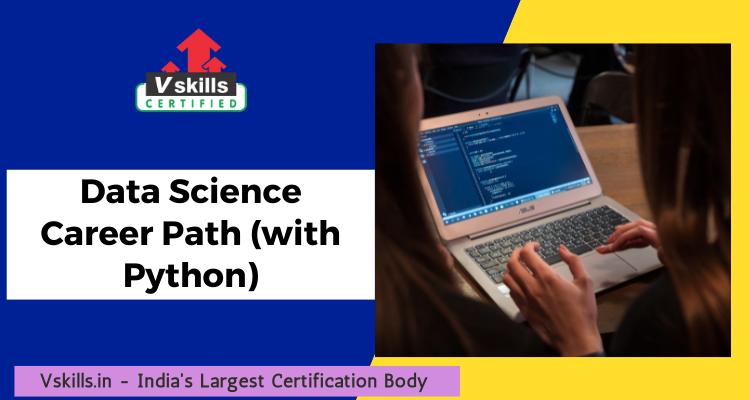Python is a multi-paradigm and high-level language that programmers utilise because it has more traditional and better features than languages like Java, C++, and others. Furthermore, its object-oriented aspect has made it even easier and more accurate to work with. Python is a key to the future of data science, according to recent headlines. Python for Data Science has become the tools and frameworks of choice for data scientists.
Let us dive deeper into Data Science Career Path with Python.
Who is Data science professional?
Mathematicians, trend-spotters, and computer scientists make up data scientists. The data scientist’s job is to decode massive amounts of data and perform additional analysis to uncover trends and obtain a better understanding of what it all means. Data scientists bridge the gap between the business and IT sectors, driving industries by analysing large datasets and extracting insights that businesses can use to take action.
How should I start learning Python for data science?
The experts at IBM predicted a 28% increase in demand for data scientists by the year 2020. Data science experts are speculating this trend to continue with increasing development in the Python ecosystem. And while your journey to learn Python programming may be just beginning, it’s bit satisfying to know that employment opportunities are too much and will continue to grow as well.
Here are some steps that you can follow if you are beginner in learning about python in data science!
Step 1 – Start by learning Fundamentals
Before becoming an expert in some field, it is very much essential that you have a strong base. A proper conceptual knowledge is required even before you get your hands on to the practical labs. Everyone starts somewhere. You need to take baby steps if you want to build a successful career in this field. Firstly, begin your journey by learn completely about python. And then, you can learn about how and why python is used in data sciences. There are many resources which you can use for starting your journey such as taking the certification courses by various sites such as Vskills, Coursera, Udemy and so many others too. A certification course by Vskills is described in subsequent paragraphs which is a reliable source and can help you gain best knowledge.
You can also take the help of online community where you can find like minded people which will offer you guidance and can also tell you about the other resources. Furthermore, you can also take the help of Jupyter Notebook, which comes prepackaged with Python libraries to help you learn these two things. You will find some resources in the subsequent paragraphs offered by Vskills.
Step 2 – Practice Mini Python projects side by side
Practicing is, essentially, a very much important part of the learning process. When it comes to the practical aspects like implementing python in projects, having some experience can help you outshine others. Try programming things like calculators for an online game, or a program that fetches the weather from Google in your city. Building mini projects like these will help you learn Python. programming projects like these are standard for all languages, and a great way to solidify your understanding of the basics.
You can supplement your learning with the help of reading the blogs and tutorials by various sites which will help you to grasp a better understanding of the practical aspect.
Step 3 – Refer Data Science libraries for Python
Now that, if you followed the above two steps carefully, you developed a complete understanding of python as a language. Let us now take another step of learning the data sciences with python. In Python, there is generally a best way of doing something. The three best and most important Python libraries for data science are NumPy, Pandas, and Matplotlib. NumPy and Pandas are great for exploring and playing with data. Matplotlib is a data visualization library that makes graphs like you’d find in Excel or Google Sheets.
There are many python developers which are eager to guide and solve your doubts in this process. Again, you can refer to the online community of these developers of can find them over web. Remember that, the more deep you will study and the more practice you will do, the better would be career opportunities for you.
Step 4 – Build Your Portfolio
It is essential for a data science to have a portfolio. Your portfolio shows your skills to implement and design different codes or how perfectly you implement your skills in data sciences. These projects should include several different datasets and should leave readers with interesting insights that you’ve gleaned. Your portfolio doesn’t need a particular theme; find datasets that interest you, then come up with a way to put them together.
One of the nice things about data science is that your portfolio doubles as a resume while highlighting the skills you’ve learned, like Python programming. So, it is good to collaborate, communicate and focus on various technical competencies.
Step 5 – Implement your skills
After learning, it is very much essential to implement your skills some where in order to test yourself and know your competency. You can go for internships or freelancing in order to test your skills. It is also important to keep updating yourself with new technological advancements and keep working and developing on your own skills. You can also enroll in some of the advance learning courses which will also serve as proof that you are well aware of advanced skills. After learning, you’ll want to be comfortable with regression, classification, and k-means clustering models. You can also step into machine learning — bootstrapping models and creating neural networks using scikit-learn.
Career Prospects
Data Science is currently regarded as one of the most profitable careers in the industry. Data science careers are growing in popularity, with various possibilities in a variety of industries. Organizations are employing legions of data scientists as more and more companies adopt data science. Despite India’s position as a global leader in technical education and research, the demand-supply imbalance for data science positions against applicants is expanding.
Currently, 70% of job ads in the analytics ecosystem are for data scientists with fewer than five years of experience.
For a variety of reasons, tracing a data scientist’s career path is a little more difficult. Because the industry had not matured enough to incorporate the title of a data scientist, the majority of middle and senior-level executives, with 10-15 years of work experience, began with software or coding credentials. Things are changing now, and future generations of data scientists will have a better understanding of their job options.
Market demand and average salary
Data Science with Python is one of the faster growing filed and are in great demand. Companies like KPMG, Accenture, TCS & Cognizant specializing in Data Science related activities are constantly looking for certified professionals.
The average data scientists salary is ₹698,413. An entry-level data scientist can earn around ₹500,000 per annum with less than one year of experience. Early level data scientists with 1 to 4 years experience get around ₹610,811 per annum.

A mid-level data scientist with 5 to 9 years experience earns ₹1,004,082 per annum in India. As your experience and skills grow, your earnings rise dramatically as senior-level data scientists around more than ₹1,700,000 a year in India!
Resources
Before you can become an expert in desired areas, you must first build a solid base. Before you can move on to practical teaching, you’ll need to have the right applied skills. To gain a full understanding of the domain, you can use the following tools:
- Firstly, Online Tutorials for Data Science with Python
- MBA in Business Intelligence or any other allied field
- Also, Certification Courses from verified sources such as Vskills, Coursera, Udemy and so on.
- In addition, Online communities
- Moreover, Blogs and study material from experts in this field and many more.
Here are some examples of how you can improve your abilities:
- Freelancing
- Internships
- Apprenticeship programs
The above steps will help you to get this domain started. It’s a long way to go, however. You can take an advanced course to reach a new level of skills.
Some resources offered by Vskills
Vskills offer Data Science with Python certification for all those interested in working in this field. This certification course covers the following topics –
- Introduction to Data Science
- Python Essentials for Data Science
- Data Science ToolBox – 1
- Data Science ToolBox – 2
- Importing & Cleaning Data
- Data Visualization with Statistical Thinking
- Introduction to Machine Learning with Scikit-Learn
Vskills also offers free practice tests and online tutorials to supplement the learning process. You can check them by clicking on the following links –
Discover the career opportunities and other prospects of career in Data Science with Python. Hurry up and start preparing now with Vskills.in!



